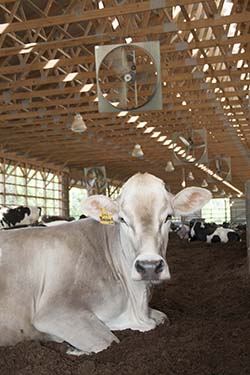 "Compost barns are not your grandfather's bedded pack," explained Jeffrey Bewley, assistant professor from the University of Kentucky, at the Missouri Grazing Conference last month. Initially hesitant about compost bedded pack barns, Bewley studied many of these facilities in Kentucky and the surrounding area. From his observations, Bewley identified three main keys to successful compost bedded pack barns.
"Compost barns are not your grandfather's bedded pack," explained Jeffrey Bewley, assistant professor from the University of Kentucky, at the Missouri Grazing Conference last month. Initially hesitant about compost bedded pack barns, Bewley studied many of these facilities in Kentucky and the surrounding area. From his observations, Bewley identified three main keys to successful compost bedded pack barns. Construct the building properly. Select a site that maximizes natural ventilation. In Kentucky, Bewley recommended an east/west orientation. The barn should be at a location that is slightly elevated, and a clay or concrete base works best.
The barn should be built for the maximum number of cows that will be milking at one time. Design the structure so that there is space for feed and water away from the bedded pack. It is better to build multiple, narrow entrances rather than one large entrance to distribute cow flow.
Fans should be installed to both cool the cows and dry the pack, and curtains can help the composting process in winter. An eave overhang of at least one-third the height of the building will help keep the pack dry as well.
Don't overstock. "Compost barns are unforgiving for overstocking," said Bewley. A minimum of 100 square feet per cow is recommended. A wider alley is also suggested since waterers and feed often share the same alley. Enough space is needed to allow cows to pass through even if others are eating and drinking.
Stir frequently. The pack needs to be aerated at least twice per day when the cows leave to be milked. Stir at least 10 to 12 inches deep. New bedding, between 2 and 8 inches, should be added when the pack starts to get moist. If good composting is occurring, the pack should be between 110°F and 115°F, which is "just hot enough that you don't want to touch it," said Bewley.
From a cow's perspective, compost bedded pack barns provide a comfortable surface to lay on and get up from, to run and play on, and to show heat. Cows can stay very clean if the pack is well-maintained. This is crucial for maintaining milk quality.
Bewley concluded that compost bedded pack barns can be a great housing option, just as properly managed freestall and tie stall barns are great places for cows as well. "It all comes down to which system you want to work with," he said.

The author is an associate editor and covers animal health, dairy housing and equipment, and nutrient management. She grew up on a dairy farm near Plymouth, Wis., and previously served as a University of Wisconsin agricultural extension agent. She received a master's degree from North Carolina State University and a bachelor's from University of Wisconsin-Madison.








